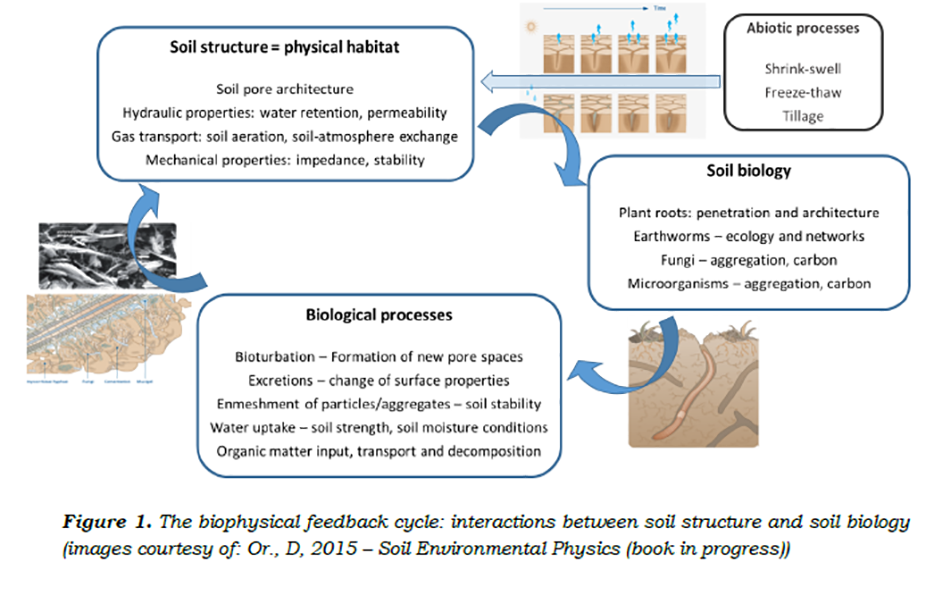Workshop
Soil supports plant growth, provides habitat for the largest diversity of soil (micro) organisms, and regulates water and gas fluxes at the interface between the atmosphere, hydrosphere and litho-sphere. Vital economic, environmental, and human health issues are dependent to the ecological and biophysical functionality of the soil.
Soil structure, i.e. the spatial arrangement of soil constituents and voids (soil pores) controls transport of fluids as water and gas, water storage, chemical reactions, and provides spaces for biological activity. These functions are related to a host of ecosystem services ranging from mainte-nance of biodiversity, to proper matrix for plant growth, controls over groundwater quality and recharge, and soil-atmosphere gas exchange. In contrast to soil texture (determined by primary particles), soil structure is a highly dynamic trait that is affected by climatic processes induced by wetting-drying and freezing-thawing phenomena, biotic processes (root growth and root water up-take, burrowing of earthworms and other fauna, microbiological activity), and soil management activities including soil tillage and soil compaction caused by agricultural vehicle traffic.
The interaction between soil biology and the physical environment constitutes a feedback cycle, as shown in Fig. 1. Soil structure defines the physical habitat of soil living organisms; the biological activity, in turn, modifies the soil physical environment, i.e. soil fauna, bacteria, fungi and plant roots change their physical habitat (Fig. 1), e.g. through creation of new pore spaces and modification of surface properties. However, knowledge of this biophysical feedback cycle is incom-plete (Bottinelli et al., 2014), especially, mechanistic understanding is limited. Most research fo-cusses on effects of changed soil physical conditions (e.g. due to soil compaction, as affected by tillage systems) on biological activity (e.g. plant growth, earthworm abundance, microbial biomass), and this research is predominantly empirical (Webb, 2002). Work on how biological activity impacts soil structure and soil physical functioning has only started to receive attention relatively recently, but new non-invasive imaging technologies and numerical models now offer possibilities for new insights (see Hallett et al., 2013). While the overwhelming majority of organisms inhabiting the soil operate at the microscale, there is a spectrum of activities by biological agents at scales ranging
Swiss National Science Foundation | 2
from millimetre (earthworms, ants, young roots) to many centimetres (rodents, ant colonies, ma-ture root zones), and in dense tropical forests, the scale of continuous subterranean biological activity may span extensive landscapes. According to Hallett et al. (2013) “a major challenge re-mains to develop a modelling framework that incorporates the key biophysical interactions ac-counting for soil structure dynamics”.

Improved mechanistic understanding of biophysical interactions and quantification of the role of biophysical processes in soil structure dynamics are essential for better assessment of the state and resilience of soil ecosystems, and for improved management of the soil biological component. At present, no clear metrics for the ecological recovery from a soil structural perturbation are available. There is conflicting evidence to the question of how long it takes soil functions and eco-system services to recover from compaction damage (compaction is considered one of the major threats to soil ecological functioning in modern and intensifying agriculture [EU, 2006]). Estimates of recovery periods range from years to centuries (Webb, 2002), reflecting on the lack of under-standing of the key processes involved in structure recovery and their rates, as well as on the lack of well-defined metrics for soil structure and ecological recovery. Improved understanding of soil structure dynamics due to biophysical processes could provide novel approaches on how to ma-nipulate biological processes to improve physical conditions of soil for agricultural production (Dexter, 1991; Hallett et al., 2013), management of grazed lands, forest harvesting activities and more. Protocols for enhancing soil structure recovery are urgently needed with the growing threat of soil compaction with the intensification of agriculture to enhance food production. Thus, soil biophysics plays an important role for food and environmental quality and security.
